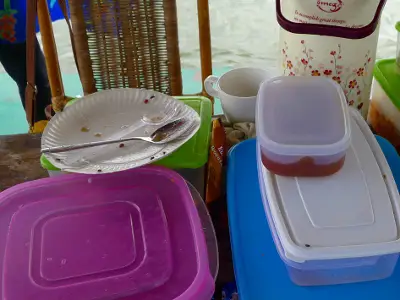What is a negative externality? Appreciate the importance of knowing and understanding externality, an environmental economics concept, by reading this article.
In environmental economics, one of the interesting and useful concepts discussed is externality. And I was reminded of this concept when I took a trip, together with friends and family, to Kitu-Kito. It is an ideal spot to spend quiet time or to commune with nature . The place can be accessed within 30-minutes of leisurely driving from the City of Puerto Princesa.
It’s a holiday so we thought of having a picnic on board a raft made of large PVC pipes that a motorized boat tows along a river towards the open, deeper parts of Honda Bay. We did a similar trip several months back—but without the flies.
Why so Many Flies?
What reminded me of the externality concept? Well, I noticed an unusually large number of flies swarming at our food. We have to keep the food containers closed.
I asked why there are so many flies that day. The pests somewhat curbed our appetite because we all know that flies are harbingers of many kinds of diseases.
According to Penn State University (2014), flies transmit at least 65 diseases to humans. Flies leave pathogenic organisms in excretions upon alighting on food.
This is disturbing as this would mean that we might ingest contaminated food because of flies landing on our meal and doing their nasty behavior of regurgitating or excreting things that we don’t want. Getting ill means lost work hours or lost opportunity to do other important things.

Just curious what could have caused this large number of flies to come and pester us, I asked the group if anyone knows why. Then our boatman said, “This happens every time those guys operating the poultry and piggery in the upland spray fumigants to get their farm rid of flies.
“Ah, that’s an excellent answer to my question. ” I nodded indicating my enlightenment. Everybody new to the place sure learned something that day.
Negative Externality of Fumigation
Flies pestering our meals is a negative externality of fumigation.
The externality in the foregoing short narrative are flies swarming the neighborhood when fumigants are in effect. They were not killed on the spot but escaped from the poultry and piggery farms. Their eggs and larvae must have been killed but the adults are scot-free—and posed danger to neighboring houses and, us, picknickers.
The escaping flies that potentially bring diseases with them is a side effect of fumigation in the poultry and piggery farms. This is a negative externality that is not reflected in the cost of services involved in the operation of the farms.
To internalize the externality or to correct the inequality in benefits as a result of the operation, the poultry and piggery farm owners should pay parties affected by their activities. They should pay us for lessened enjoyment of the sea scape and the cool breeze because we have to contend with the flies that pester our meals.
How much should they pay us? This concern requires the conduct of a study. If we complain about the negative effects of the poultry farm, we should show the link between their operation and the unusual number of flies that affect third parties like us. Also, the owner of the farms should ask us and the neighborhood how much we are willing to accept as compensation for the nuisance.
Read more about externality in the following article:
Externalities: the Mango Grower and the Beekeeper
References
Pennsylvania State University, 2014. House flies. Retrieved June 21, 2014, from http://ento.psu.edu/extension/factsheets/house-flies
© 2014 June 21 P. A. Regoniel


